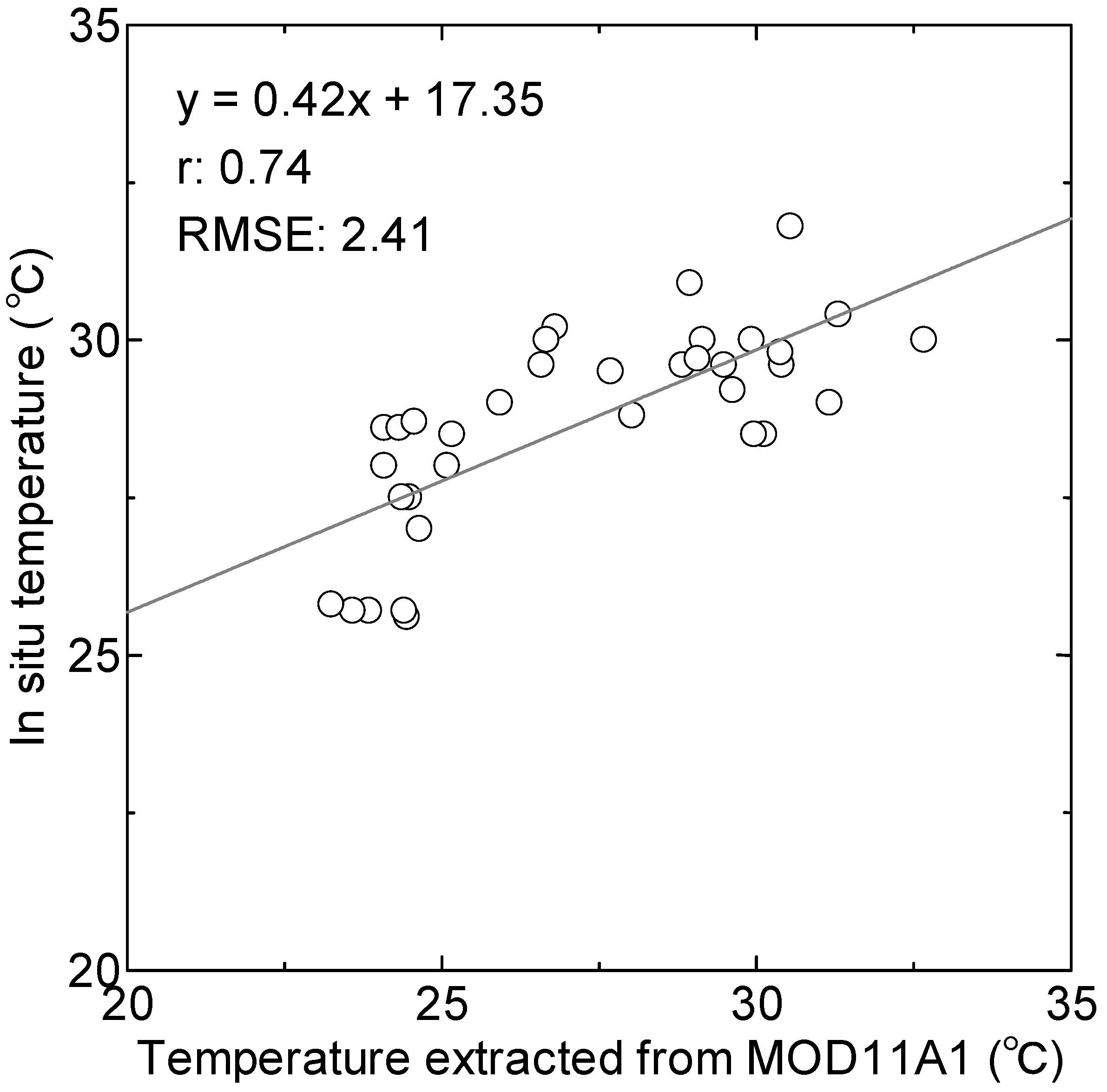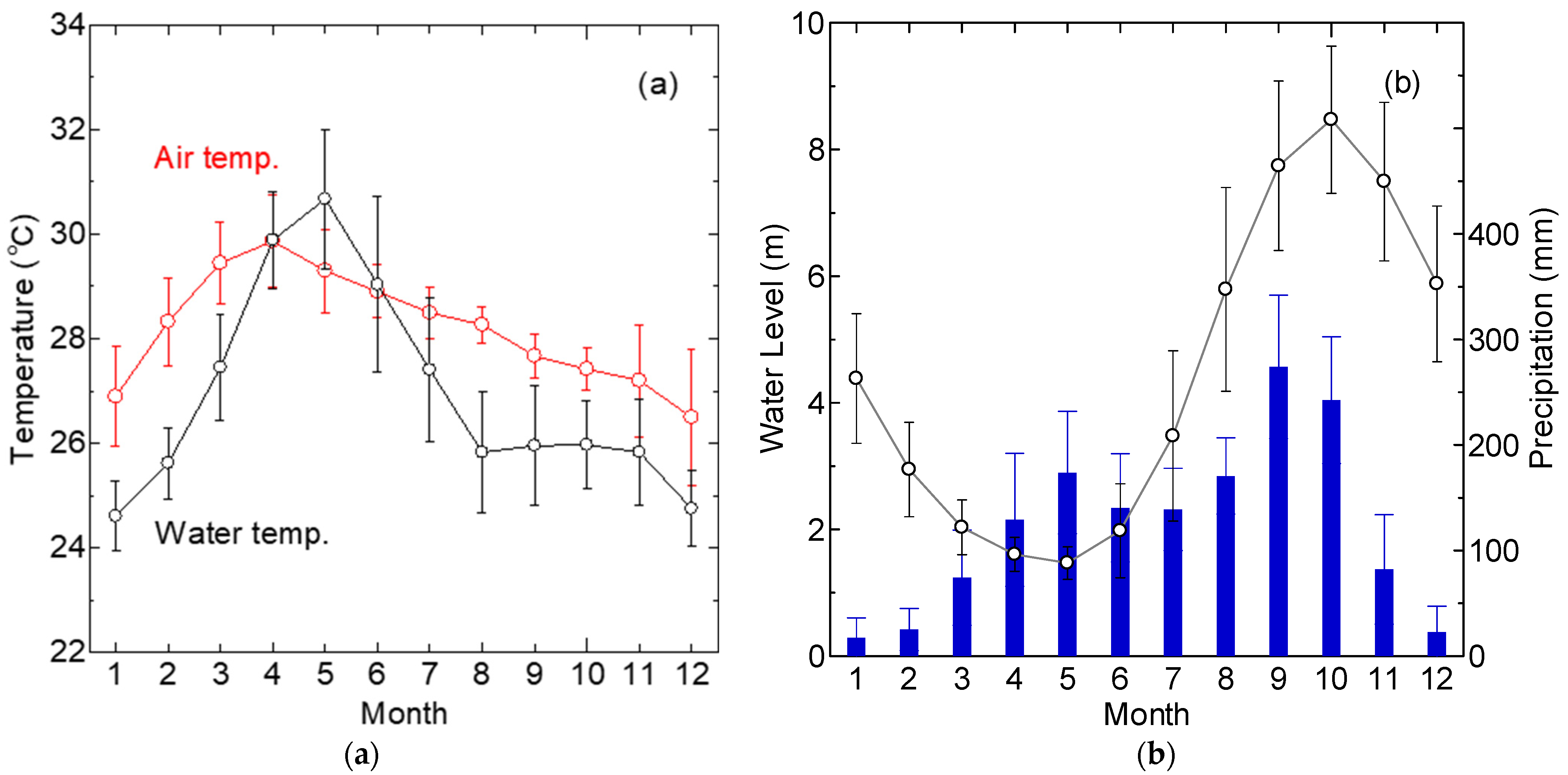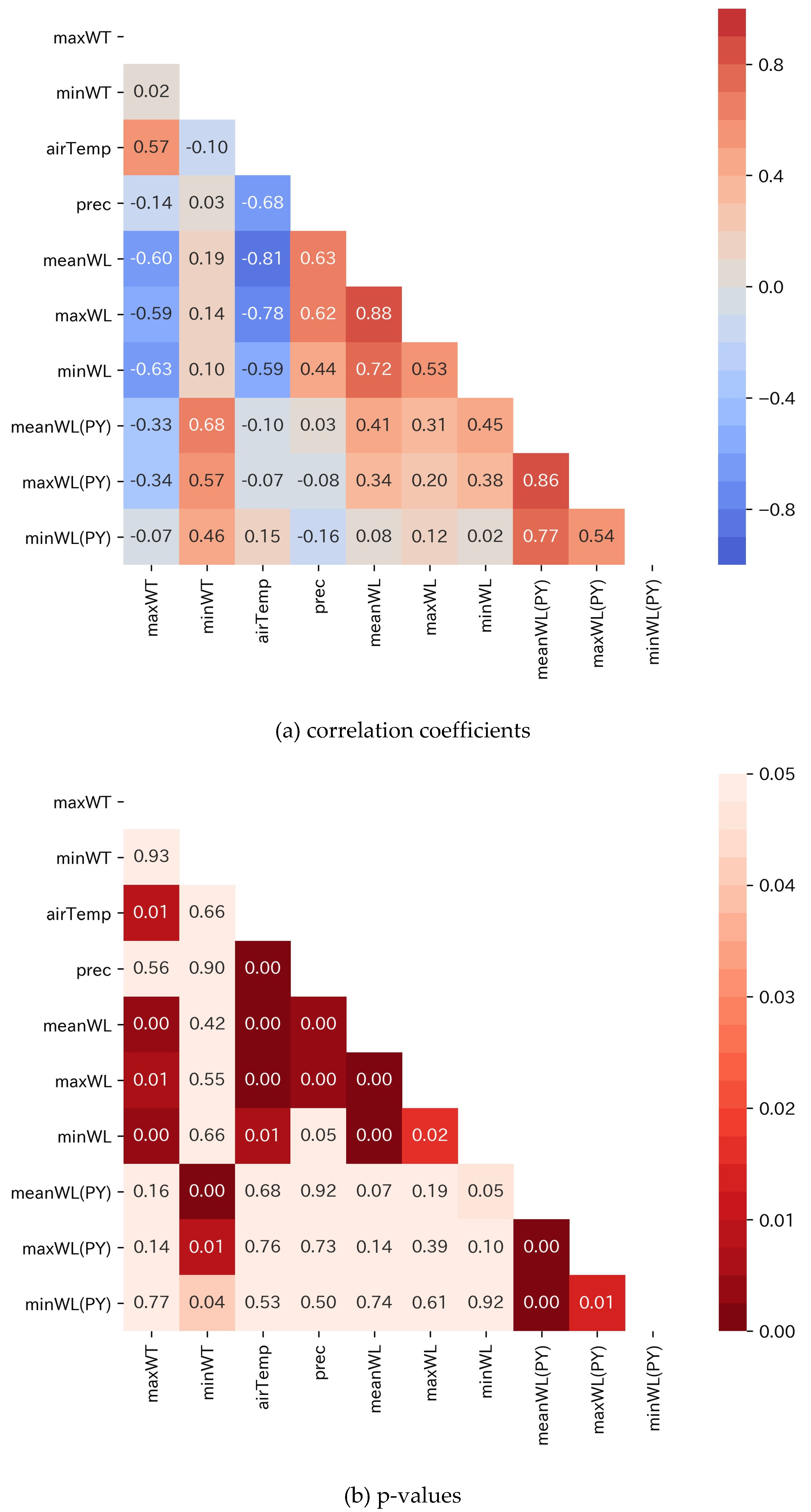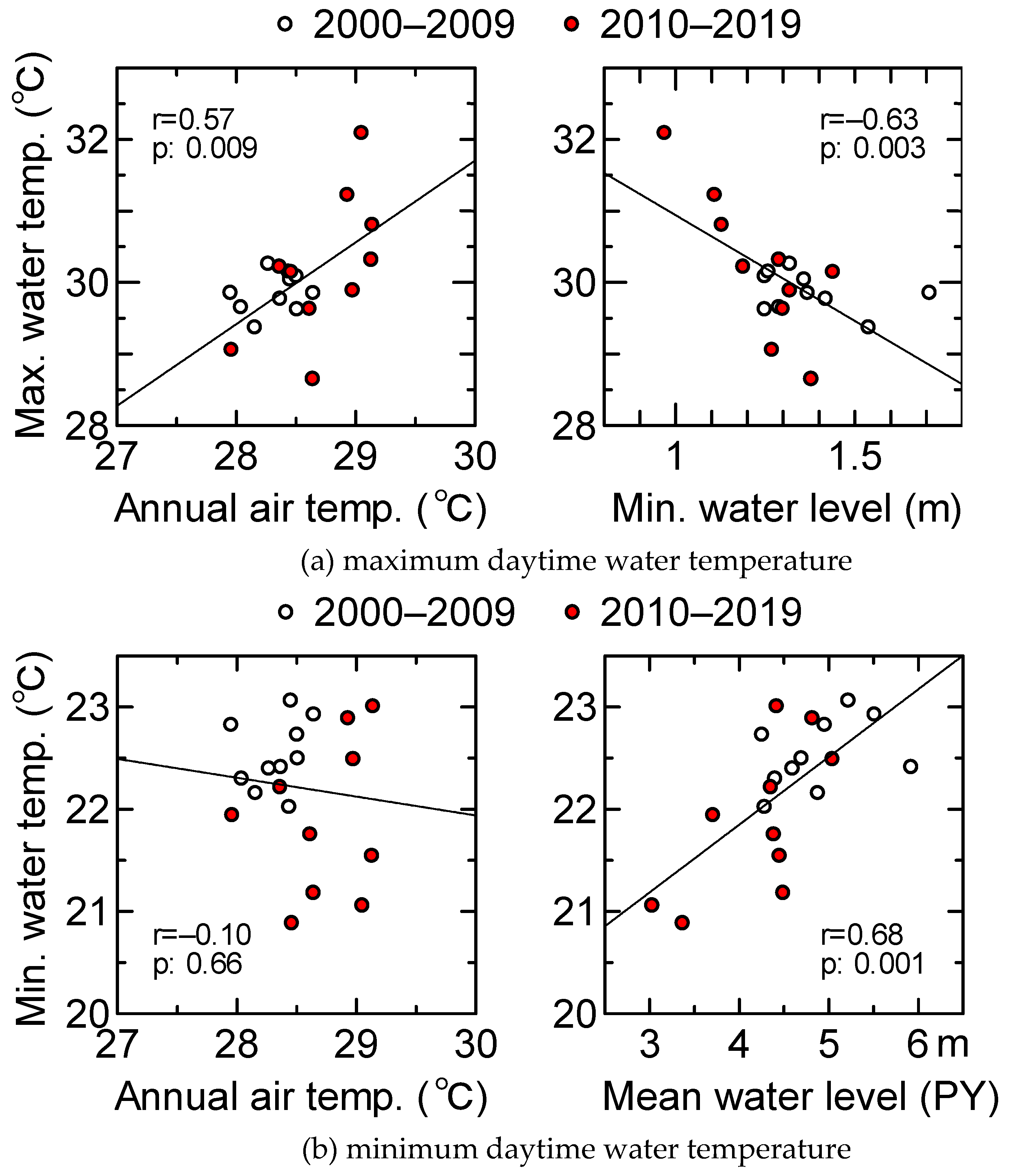Characteristics of the Annual Maximum and Minimum Water Temperatures in Tonle Sap Lake, Cambodia from 2000 to 2019
Abstract
:1. Introduction
2. Materials and Methods
2.1. Study Area
2.2. MODIS-Derived Water Temperature and In Situ Observations
2.3. Air Temperature, Precipitation, and Lake Water Level
2.4. Trend and Correlation Analysis
3. Results
3.1. MODIS-Derived Water Temperature and In Situ Observations
3.2. Seasonal Characteristics of Air Temperature, Precipitation, Water Level, and Water Temperature
3.3. Trends of Air Temperature, Precipitation, Water Level, and Water Temperature
3.4. Correlation Analysis
4. Discussion
4.1. Changes in the Annual Maximum and Minimum Water Temperatures
4.2. Limitations and Future Research
5. Conclusions
Author Contributions
Funding
Data Availability Statement
Acknowledgments
Conflicts of Interest
References
- Fujii, H.; Garsdal, H.; Ward, P.; Ishii, M.; Morishita, K.; Boivin, T. Hydrological roles of the Cambodian floodplain of the Mekong River. Int. J. River Basin Manag. 2003, 1, 253–266. [Google Scholar] [CrossRef]
- Arias, M.E.; Cochrane, T.A.; Piman, T.; Kummu, M.; Caruso, B.S.; Killeen, T.J. Quantifying changes in flooding and habitats in the Tonle Sap Lake (Cambodia) caused by water infrastructure development and climate change in the Mekong Basin. J. Environ. Manag. 2012, 112, 53–66. [Google Scholar] [CrossRef]
- Uk, S.; Yoshimura, C.; Siev, S.; Try, S.; Yang, H.; Oeurng, C.; Li, S.; Hul, S. Tonle Sap Lake: Current status and important research directions for environmental management. Lakes Reserv. Res. Manag. 2018, 23, 177–189. [Google Scholar] [CrossRef]
- Campbell, I.C.; Poole, C.; Giesen, W.; Valbo-Jorgensen, J. Species diversity and ecology of Tonle Sap Great Lake, Cambodia. Aquat. Sci. 2006, 68, 355–373. [Google Scholar] [CrossRef]
- Baran, E.; Myschowoda, C. Dams and fisheries in the Mekong Basin. Aquat. Ecosyst. Health Manag. 2009, 12, 227–234. [Google Scholar] [CrossRef]
- Arias, M.E.; Cochrane, T.A.; Norton, D.; Killeen, T.J.; Khon, P. The flood pulse as the underlying driver of vegetation in the largest wetland and fishery of the Mekong Basin. Ambio 2013, 42, 864–876. [Google Scholar] [CrossRef] [PubMed] [Green Version]
- Pool, T.; Holtgrieve, G.; Elliott, V.; McCann, K.; McMeans, B.; Rooney, N.; Smits, A.; Phanara, T.; Cooperman, M.; Clark, S.; et al. Seasonal increases in fish trophic niche plasticity within a flood-pulse river ecosystem (Tonle Sap Lake, Cambodia). Ecosphere 2017, 8, e01881. [Google Scholar] [CrossRef]
- Bonheur, N.; Lane, B.D. Natural resources management for human security in Cambodia’s Tonle Sap Biosphere Reserve. Environ. Sci. Policy 2002, 5, 33–41. [Google Scholar] [CrossRef]
- Sithirith, M. Tonle Sap Lake, Cambodia: A perspective on its transborder hydrological and resources governance. Lakes Reserv. Res. Manag. 2015, 20, 187–205. [Google Scholar] [CrossRef]
- O’Reilly, C.M.; Sharma, S.; Gray, D.K.; Hampton, S.E.; Read, J.S.; Rowley, R.J.; Schneider, P.; Lenters, J.D.; McIntyre, P.B.; Kraemer, B.M.; et al. Rapid and highly variable warming of lake surface waters around the globe. Geophys. Res. Lett. 2015, 42, 10773–10781. [Google Scholar] [CrossRef] [Green Version]
- Best, J. Anthropogenic stresses on the world’s big rivers. Nat. Geosci. 2019, 12, 7–21. [Google Scholar] [CrossRef]
- Schneider, P.; Hook, S.J. Space observations of inland water bodies show rapid surface warming since 1985. Geophys. Res. Lett. 2010, 37, L22405. [Google Scholar] [CrossRef] [Green Version]
- Yang, K.; Yu, Z.; Luo, Y.; Zhou, X.; Shang, C. Spatial-temporal variation of lake surface water temperature and its driving factors in Yunnan-Guizhou Plateau. Water Resour. Res. 2019, 55. [Google Scholar] [CrossRef]
- Zhang, G.; Yao, T.; Xie, H.; Qin, J.; Ye, Q.; Dai, Y.; Guo, R. Estimating surface temperature changes of lakes in the Tibetan Plateau using MODIS LST data. J. Geophys. Res. Atmos. 2014, 119, 8552–8567. [Google Scholar] [CrossRef]
- Cochrane, T.A.; Arias, M.E.; Piman, T. Historical impact of water infrastructure on water levels of the Mekong River and the Tonle Sap system. Hydrol. Earth Syst. Sci. 2014, 18, 4529–4541. [Google Scholar] [CrossRef] [Green Version]
- Lin, Z.; Qi, J. Hydro-dam—A nature-based solution or an ecological problem: The fate of the Tonlé Sap Lake. Environ. Res. 2017, 158, 24–32. [Google Scholar] [CrossRef]
- Ji, X.; Li, Y.; Luo, X.; He, D. Changes in the lake area of Tonle Sap: Possible linkage to runoff alterations in the Lancang River? Remote Sens. 2018, 10, 866. [Google Scholar] [CrossRef] [Green Version]
- Pokhrel, Y.; Burbano, M.; Roush, J.; Kang, H.; Sridhar, V.; Hyndman, D.W. A review of the integrated effects of changing climate, land use, and dams on Mekong River hydrology. Water 2018, 10, 266. [Google Scholar] [CrossRef] [Green Version]
- Oyagi, H.; Endoh, S.; Ishikawa, T.; Okumura, Y.; Tsukawaki, S. Seasonal changes in water quality as affected by water level fluctuations in Lake Tonle Sap, Cambodia. Geogr. Rev. Jpn. Ser. B 2017, 90, 53–65. [Google Scholar] [CrossRef] [Green Version]
- Daly, K.; Ahmad, S.K.; Bonnema, M.; Beveridge, C.; Hossain, F.; Nijssen, B.; Holtgrieve, G. Recent warming of Tonle Sap Lake, Cambodia: Implications for one of the world’s most productive inland fisheries. Lakes Reserv. Res. Manag. 2020, 25, 133–142. [Google Scholar] [CrossRef]
- Pan, M.; Yang, K. Analysis of variation characteristics and driving factors of Tonle Sap Lake’s surface water temperature from 2001 to 2018. Pol. J. Environ. Stud. 2021, 30, 1–14. [Google Scholar] [CrossRef]
- Hoshikawa, K.; Fujihara, Y.; Siev, S.; Arai, S.; Nakamura, T.; Fujii, H.; Sok, T.; Yoshimura, C. Characterization of total suspended solid dynamics in a large shallow lake using long-term daily satellite images. Hydrol. Process. 2019, 33, 2745–2758. [Google Scholar] [CrossRef]
- Kummu, M.; Tes, S.; Yin, S.; Adamson, P.; Józsa, J.; Koponen, J.; Richey, J.; Sarkkula, J. Water balance analysis for the Tonle Sap Lake-floodplain system. Hydrol. Process. 2014, 28, 1722–1733. [Google Scholar] [CrossRef]
- Siev, S.; Yang, H.; Sok, T.; Uk, S.; Song, L.; Kodikara, D.; Oeurng, C.; Hul, S.; Yoshimura, C. Sediment dynamics in a large shallow lake characterized by seasonal flood pulse in Southeast Asia. Sci. Total Environ. 2018, 631–632, 597–607. [Google Scholar] [CrossRef]
- Kummu, M.; Penny, D.; Sarkkula, J.; Koponen, J. Sediment: Curse or blessing for Tonle Sap Lake? Ambio 2008, 37, 158–163. [Google Scholar] [CrossRef]
- Kummu, M.; Sarkkula, J.; Koponen, J.; Nikula, J. Ecosystem management of the Tonle Sap Lake: An integrated modelling approach. Int. J. Water Resour. Dev. 2006, 22, 497–519. [Google Scholar] [CrossRef]
- Halls, A.S.; Hortle, K.G. Flooding is a key driver of the Tonle Sap dai fishery in Cambodia. Sci. Rep. 2021, 11, 3806. [Google Scholar] [CrossRef] [PubMed]
- Khanal, R.; Uk, S.; Kodikara, D.; Siev, S.; Yoshimura, C. Impact of water level fluctuation on sediment and phosphorous dynamics in Tonle Sap Lake, Cambodia. Water Air Soil Pollut. 2021, 232, 139. [Google Scholar] [CrossRef]
- Lehner, B.; Döll, P. Development and validation of a global database of lakes, reservoirs and wetlands. J. Hydrol. 2004, 296, 1–22. [Google Scholar] [CrossRef]
- Crosman, E.T.; Horel, J.D. MODIS-derived surface temperature of the Great Salt Lake. Remote Sens. Environ. 2009, 113, 73–81. [Google Scholar] [CrossRef]
- Sima, S.; Ahmadalipour, A.; Tajrishy, M. Mapping surface temperature in a hyper-saline lake and investigating the effect of temperature distribution on the lake evaporation. Remote Sens. Environ. 2013, 136, 374–385. [Google Scholar] [CrossRef]
- Xiao, F.; Ling, F.; Du, Y.; Feng, Q.; Yan, Y.; Chen, H. Evaluation of spatial-temporal dynamics in surface water temperature of Qinghai Lake from 2001 to 2010 by using MODIS data. J. Arid Land 2013, 5, 452–464. [Google Scholar] [CrossRef]
- Gorelick, N.; Hancher, M.; Dixon, M.; Ilyushchenko, S.; Thau, D.; Moore, R. Google Earth Engine: Planetary-scale geospatial analysis for everyone. Remote Sens. Environ. 2017, 202, 18–27. [Google Scholar] [CrossRef]
- Wan, W.; Li, H.; Xie, H.; Hong, Y.; Long, D.; Zhao, L.; Han, Z.; Cui, Y.; Liu, B.; Wang, C.; et al. A comprehensive data set of lake surface water temperature over the Tibetan Plateau derived from MODIS LST products 2001–2015. Sci. Data 2017, 4, 170095. [Google Scholar] [CrossRef] [PubMed]
- Muñoz-Sabater, J. ERA5-Land Monthly Averaged dData from 1981 to Present, Copernicus Climate Change Service (C3S) Climate Data Store (CDS), 2019. Available online: https://doi.org/10.24381/cds.68d2bb30 (accessed on 4 October 2021).
- Kendall, M.G. Rank Correlation Measures; Charles Griffin: London, UK, 1975. [Google Scholar]
- Sen, P.K. Estimates of the regression coefficient based on Kendall’s tau. J. Am. Stat. Assoc. 1968, 63, 1379–1389. [Google Scholar] [CrossRef]
- Kahya, E.; Kalaycı, S. Trend analysis of streamflow in Turkey. J. Hydrol. 2004, 289, 128–144. [Google Scholar] [CrossRef]
- Karmeshu, N. Trend Detection in Annual Temperature and Precipitation Using the Mann Kendall Test—A Case Study to Assess Climate Change on Select States in the Northeastern United States. Master of Environmental Studies Capstone Projects 2012, 47. Available online: https://repository.upenn.edu/mes_capstones/47 (accessed on 4 October 2021).
- Fujihara, Y.; Hoshikawa, K.; Fujii, H.; Yokoyama, S.; Kotera, A.; Nagano, T. Analysis and attribution of trends in water levels in the Vietnamese Mekong Delta. Hydrol. Process. 2016, 30, 835–845. [Google Scholar] [CrossRef]
- Kishcha, P.; Starobinets, B.; Lechinsky, Y.; Alpert, P. Absence of surface water temperature trends in Lake Kinneret despite present atmospheric warming: Comparisons with Dead Sea trends. Remote Sens. 2021, 13, 3461. [Google Scholar] [CrossRef]
- Arias, M.E.; Piman, T.; Lauri, H.; Cochrane, T.A.; Kummu, M. Dams on Mekong tributaries as significant contributors of hydrological alterations to the Tonle Sap Floodplain in Cambodia. Hydrol. Earth Syst. Sci. 2014, 18, 5303–5315. [Google Scholar] [CrossRef] [Green Version]
- Hecht, J.S.; Lacombe, G.; Arias, M.E.; Dang, T.D.; Piman, T. Hydropower dams of the Mekong River basin: A review of their hydrological impacts. J. Hydrol. 2019, 568, 285–300. [Google Scholar] [CrossRef]
- Bonnema, M.; Hossain, F.; Nijssen, B.; Holtgrieve, G. Hydropower’s hidden transformation of rivers in the Mekong. Environ. Res. Lett. 2020, 15, 044017. [Google Scholar] [CrossRef] [Green Version]
- Wang, Y.; Feng, L.; Liu, J.; Hou, X.; Chen, D. Changes of inundation area and water turbidity of Tonle Sap Lake: Responses to climate changes or upstream dam construction? Environ. Res. Lett. 2020, 15, 0940a1. [Google Scholar] [CrossRef]
- Gan, G.; Liu, Y. Heat storage effect on evaporation estimates of China’s largest freshwater lake. J. Geophys. Res. Atmos. 2021, 125, e2019JD032334. [Google Scholar] [CrossRef]







Publisher’s Note: MDPI stays neutral with regard to jurisdictional claims in published maps and institutional affiliations. |
© 2021 by the authors. Licensee MDPI, Basel, Switzerland. This article is an open access article distributed under the terms and conditions of the Creative Commons Attribution (CC BY) license (https://creativecommons.org/licenses/by/4.0/).
Share and Cite
Fujihara, Y.; Okuyama, K.; Hoshikawa, K.; Fujii, H.; Nakamura, T.; Lun, S.; Siev, S. Characteristics of the Annual Maximum and Minimum Water Temperatures in Tonle Sap Lake, Cambodia from 2000 to 2019. Remote Sens. 2021, 13, 3972. https://doi.org/10.3390/rs13193972
Fujihara Y, Okuyama K, Hoshikawa K, Fujii H, Nakamura T, Lun S, Siev S. Characteristics of the Annual Maximum and Minimum Water Temperatures in Tonle Sap Lake, Cambodia from 2000 to 2019. Remote Sensing. 2021; 13(19):3972. https://doi.org/10.3390/rs13193972
Chicago/Turabian StyleFujihara, Yoichi, Koki Okuyama, Keisuke Hoshikawa, Hideto Fujii, Takashi Nakamura, Sambo Lun, and Sokly Siev. 2021. "Characteristics of the Annual Maximum and Minimum Water Temperatures in Tonle Sap Lake, Cambodia from 2000 to 2019" Remote Sensing 13, no. 19: 3972. https://doi.org/10.3390/rs13193972





